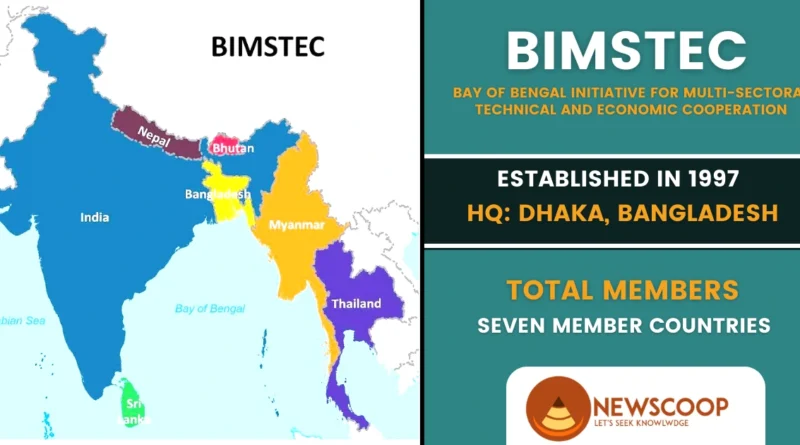BIMSTEC: History, Headquarters & Member Countries
The Bay of Bengal Initiative for Multi-Sectoral Technical and Economic Cooperation (BIMSTEC) is a dynamic regional organization consisting of seven member countries: Bangladesh, Bhutan, India, Myanmar, Nepal, Sri Lanka, and Thailand. BIMSTEC offers a fascinating area of study for UPSC aspirants due to its relevance in multiple dimensions of international relations, regional cooperation, and economic development.
In this article, we delve into the significance of BIMSTEC for UPSC preparation and explore key areas that candidates should focus on.
Bay of Bengal Initiative for Multi-Sectoral Technical and Economic Cooperation (BIMSTEC)
The formation of the Bay of Bengal Initiative for Multi-Sectoral Technical and Economic Cooperation (BIMSTEC) was driven by the need for increased regional cooperation and integration among countries in the Bay of Bengal region. The history of its formation traces back to the early 1990s and involves the collaboration of several nations.
History & Formation of BIMSTEC
During the 1990s, there was a growing recognition among countries in the Bay of Bengal region of the need for closer economic ties and enhanced cooperation. Various bilateral and multilateral initiatives were explored to promote economic growth and address shared challenges.
1. Formation of BIST-EC: In 1997, four countries – Bangladesh, India, Sri Lanka, and Thailand – initiated the establishment of the Bangladesh-India-Sri Lanka-Thailand Economic Cooperation (BIST-EC). The focus was on promoting economic cooperation and enhancing trade and investment among these nations.
Founding Members of BIST-EC:
- Bangladesh
- India
- Sri Lanka
- Thailand
2. Expansion and Inclusion of Myanmar: In 1997, Myanmar expressed interest in joining the BIST-EC initiative. Recognizing the strategic importance of Myanmar as a link between South and Southeast Asia, the member countries welcomed Myanmar’s participation, and BIST-EC became a five-nation organization.
3. Emergence of BIMST-EC: In 1997, the acronym BIST-EC was expanded to include the word “Multi-Sectoral,” and the organization was renamed the Bay of Bengal Initiative for Multi-Sectoral Technical and Economic Cooperation (BIMST-EC). This change reflected the broader scope of cooperation beyond just economic aspects.
4. Inclusion of Bhutan and Nepal: Realizing the potential for greater regional integration, Bhutan and Nepal expressed their interest in joining BIMST-EC. In 2004, both countries officially became members, transforming BIMST-EC into BIMSTEC.
5. Official Formation and Bangkok Declaration: On 6 June 1997, the leaders of Bangladesh, India, Myanmar, Sri Lanka, and Thailand gathered in Bangkok and signed the Bangkok Declaration, marking the official formation of BIMSTEC. The declaration outlined the objectives, principles, and areas of cooperation for the organization.

Member Countries of BIMSTEC
The Bay of Bengal Initiative for Multi-Sectoral Technical and Economic Cooperation (BIMSTEC) consists of seven member countries:
- Bangladesh
- Bhutan
- India
- Myanmar
- Nepal
- Sri Lanka
- Thailand
Objectives of BIMSTEC
The key objectives of BIMSTEC are as follows:
- Promote economic cooperation and trade facilitation among member countries.
- Enhance connectivity, including transport, communication, and energy linkages.
- Foster cooperation in sectors such as agriculture, tourism, fisheries, public health, poverty alleviation, and counter-terrorism.
- Strengthen collaboration in disaster management, climate change adaptation, and sustainable development.
- Facilitate people-to-people exchanges, cultural cooperation, and knowledge sharing.
Principles of BIMSTEC
Some of the key principles of BIMSTEC are:
- Sovereign Equality
- Non-Interference
- Cooperation for Mutual Benefit
- Inclusivity and Open Regionalism
- Respect for Diversity
- Good Governance and Rule of Law
- People-Centric Approach
- Sustainable Development
Headquarters
The headquarters of BIMSTEC is located in Dhaka, Bangladesh.
Areas of Cooperation
Areas of cooperation in BIMSTEC include:
- Trade and Investment
- Technology
- Energy
- Tourism
- Fisheries
- Agriculture
- People-to-People Contact
- Counter-Terrorism and Transnational Crime
- Climate Change
Structure of BIMSTEC
| Structure | Description |
|---|---|
| Leaders’ Summit | Highest decision-making body |
| Ministerial Meetings | Sector-specific discussions |
| Senior Officials’ Meetings | Coordination and recommendations |
| Working Groups | Focus on specific areas of cooperation |
| BIMSTEC Secretariat | Administrative support and coordination |
| Specialized Centers | Expertise and technical assistance |
BIMSTEC 5th Summit in 2022
The BIMSTEC 5th summit, held in Colombo, Sri Lanka, resulted in key outcomes for the organization. The adoption and signing of the BIMSTEC Charter formalized the grouping as an organized institution of coastal and Bay of Bengal-dependent member states. This charter establishes the organization’s structure and principles.
Additionally, the summit saw significant progress in the connectivity agenda, with the adoption of the “Master Plan for Transport Connectivity.” This framework will enhance regional connectivity and facilitate the movement of goods, services, and people. These outcomes strengthen it’s role in promoting cooperation, prosperity, and resilience among member states.
The key highlights of the BIMSTEC 5th summit are as follows:
- The signing of the BIMSTEC Charter formalizes the organization and establishes its purpose and principles.
- Attainment of an international personality, emblem, and flag for BIMSTEC.
- Division of work into seven segments, with India leading the security pillar.
- Introduction of the Master Plan for Transport Connectivity, promoting regional and domestic connectivity.
- India’s contribution of one million US dollars to the operational budget of the BIMSTEC Secretariat.
Also Read: Asian Development Bank
Conclusion
In conclusion, BIMSTEC is a regional organization focused on promoting cooperation among seven member countries. Through its formal structure and various mechanisms such as summits, meetings, working groups, and specialized centers, facilitates dialogue and collaboration in areas such as trade, investment, technology, energy, and more.
By fostering regional integration and addressing common challenges, BIMSTEC contributes to the socio-economic development and well-being of its member nations in the Bay of Bengal region.
Thank You!

